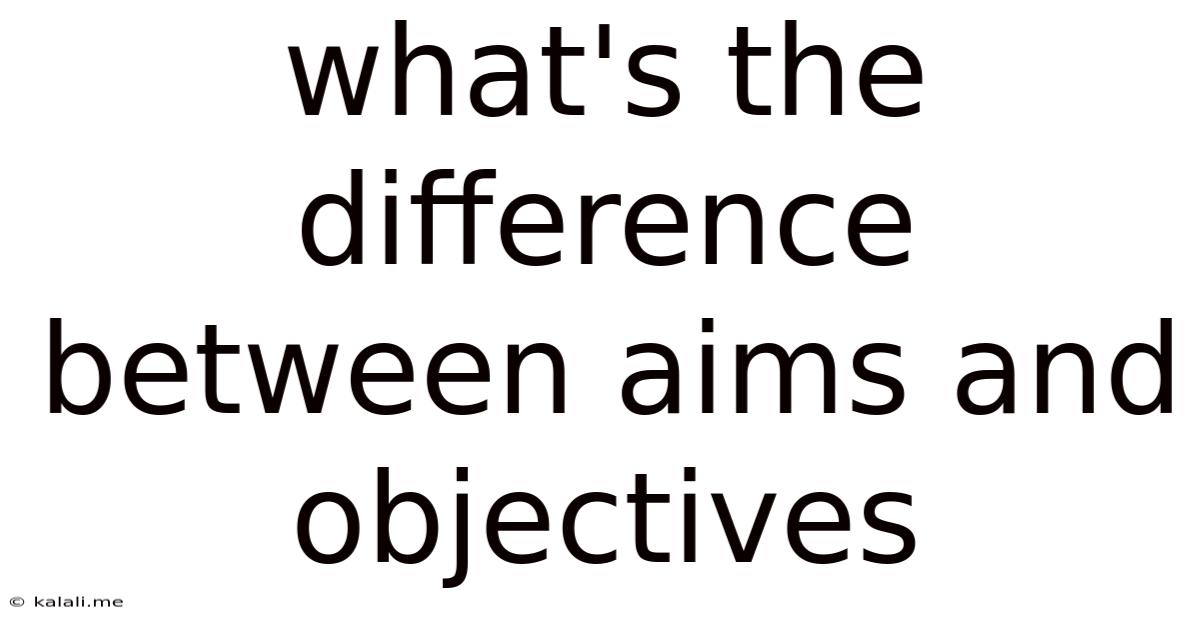What's The Difference Between Aims And Objectives
Kalali
Jun 11, 2025 · 3 min read

Table of Contents
Aims vs. Objectives: What's the Difference? A Guide to Clear Goal Setting
Understanding the difference between aims and objectives is crucial for effective planning and achieving success in any endeavor, whether it's a personal project, a business strategy, or a research paper. While often used interchangeably, these terms represent distinct levels of goal-setting. This article will clarify the key distinctions between aims and objectives, providing practical examples to help you better understand and apply them.
Meta Description: Learn the crucial difference between aims and objectives. This guide clarifies the distinction, providing practical examples to enhance your planning and goal-setting skills for personal and professional success.
Many people struggle to differentiate between aims and objectives, often using the terms synonymously. However, there is a significant difference. Aims are broad, long-term goals that provide overall direction. Objectives, on the other hand, are specific, short-term, measurable steps taken to achieve those aims. Think of aims as the destination and objectives as the roadmap to get there.
Aims: The Big Picture
Aims are aspirational and often qualitative. They set a general direction and provide a sense of purpose. They are typically broad statements that are difficult to measure directly. Key characteristics of aims include:
- Broad and overarching: Aims describe the ultimate desired outcome, a general vision of what you want to accomplish.
- Long-term focus: Aims are usually achieved over an extended period.
- Qualitative rather than quantitative: They focus on the 'what' rather than the 'how much' or 'how many.'
- Inspiring and motivating: They provide a sense of purpose and direction.
Example: An aim might be "To improve the overall health and well-being of the community." This is a broad statement that doesn't specify how this will be achieved.
Objectives: The Detailed Roadmap
Objectives are the concrete steps you take to reach your aims. They are specific, measurable, achievable, relevant, and time-bound (SMART). This makes them easy to track and measure progress towards the overarching aim. Key characteristics of objectives include:
- Specific and measurable: Objectives clearly define what needs to be accomplished and how success will be measured.
- Achievable and realistic: Objectives should be attainable within the given resources and timeframe.
- Relevant to the aim: Objectives should directly contribute to achieving the overall aim.
- Time-bound: Objectives have deadlines to ensure accountability and progress tracking.
Example: To achieve the aim of "improving the overall health and well-being of the community," some objectives might include:
- To increase community participation in health awareness programs by 20% within six months.
- To establish a community garden to promote healthy eating habits within one year.
- To reduce smoking rates among teenagers by 15% within two years.
Aims and Objectives Working Together
Aims and objectives are interdependent; objectives provide a clear path to reach the aims. Without well-defined objectives, an aim remains just a wish. Conversely, objectives without a clear aim lack direction and purpose. Successful planning involves carefully crafting aims that inspire and then developing specific, measurable objectives to make them a reality.
Using both aims and objectives provides a structured approach to planning and achieving your goals, whether it's launching a new product, improving employee satisfaction, or writing a compelling blog post. By defining your aims first, you establish a strong foundation. Then, by developing specific, measurable objectives, you create a roadmap to successfully reach your destination. This clear and focused approach increases the likelihood of achieving your ultimate goals.
Latest Posts
Latest Posts
-
How Many Ounces Are In 9 Pounds
Jul 01, 2025
-
What Kind Of Room Has No Doors Or Windows
Jul 01, 2025
-
How Many Cups Of Elbow Macaroni Are In A Pound
Jul 01, 2025
-
How Many Guppies In A 5 Gallon Tank
Jul 01, 2025
-
How To Beat Stage 7 In Bloxorz
Jul 01, 2025
Related Post
Thank you for visiting our website which covers about What's The Difference Between Aims And Objectives . We hope the information provided has been useful to you. Feel free to contact us if you have any questions or need further assistance. See you next time and don't miss to bookmark.